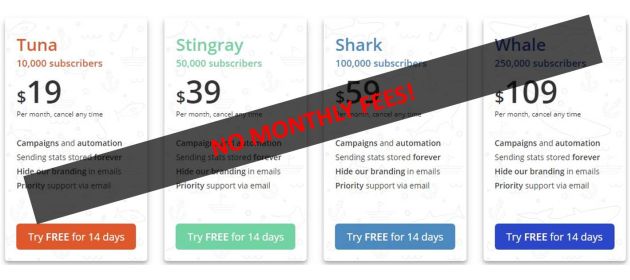As I highlighted in my blog post titled SAAS – What’s In It For Vendors?, the total subscription fees for three years of a SAAS software often exceeds the lifetime license cost for an equivalent onpremise software.
Eventually, your prospects and customers will cotton on to this when they “do the math”, as McKinsey predicts in Subscription myth busters.
Charging SAAS subscriptions to credit cards and expensing them has become a thing of the past. According to Ben Horowitz, cofounder and general partner of the venture capital firm Andreessen Horowitz, the formerly rampant practice has actually become a firing offence in many companies nowadays. SAAS has become like any other item bought by a company and subject to the cumbersome invoice approval process.
The combination of these two factors is prompting many prospects (and customers) to ask for a single, onetime fee for lifetime subscription of SAAS software.
The reflexive reaction of many SAAS vendors is to reject their request because nobody wants to provide unlimited service for a limited price.
However some vendors have read the tea leaves and have moved on to the next topic of how much to charge for lifetime subscription for their SAAS software. The OP of the following question on Quora is a case in point.
How much should I charge for a lifetime access to my SaaS that costs $100 per month?
In this post, I’ll be making the case for SAAS vendors to accept their prospect’s demand. Because, if they don’t, their prospects will find another vendor who does, especially those in the growth phase.
Ditto even if the demand comes from your existing customers. If you decline, you’d run the risk that they’d churn out to a competitor once their contract with you ends at the end of the month, or at most, year.
I’ll also tell you in this post how to make money by providing lifetime access for a single, onetime fee.
But, before that, let me take you back memory lane and tell you a short story.
 Back in the day when floppy diskettes were a thing, 3M used to sell them under the brand name IMATION. Its USP was “lifetime warranty”. Everyone assumed it spanned the lifetime of the customer. When a floppy became defective, most customers would just chuck it. But there was always this one-odd customer who would approach 3M with a warranty claim. It was only then they learned that “lifetime” meant the lifetime of the diskette! Since the diskette was defective, its lifetime was deemed to have ended. Ergo the warranty had expired. Quite often, this happened within the first year of purchase of the diskette. So, effectively, 3M’s so-called lifetime warranty actually provided a shorter cover than its competitors’ standard one-year warranty!
Back in the day when floppy diskettes were a thing, 3M used to sell them under the brand name IMATION. Its USP was “lifetime warranty”. Everyone assumed it spanned the lifetime of the customer. When a floppy became defective, most customers would just chuck it. But there was always this one-odd customer who would approach 3M with a warranty claim. It was only then they learned that “lifetime” meant the lifetime of the diskette! Since the diskette was defective, its lifetime was deemed to have ended. Ergo the warranty had expired. Quite often, this happened within the first year of purchase of the diskette. So, effectively, 3M’s so-called lifetime warranty actually provided a shorter cover than its competitors’ standard one-year warranty!
While sourcing the picture you see on the right, I was shocked to find out that brand new 3M floppy diskettes are still available for sale! Some things never seem to go away!! But I digress.
I’m not advocating 3M’s strategy but I indulged in this blast from the past just to open your eyes to the alternative ways in which your competitor might interpret your prospect’s request for “lifetime access”.
With that out of the way, let’s assume that “lifetime” means the lifetime of your prospect’s company.
The most obvious issue for you is that your prospect-turned-customer company lives and uses your software forever, and you’re stuck with finite fees for infinite service.
While that’s a clear and present danger, there are other possibilities e.g. Your prospect-turned-customer company
- Folds up
- Gets acquired by another company, which decides not to use your software for the merged entity
- Junks your SAAS at the end of the current contract for extraneous reasons.
In these days of VUCA, any of these alternative scenarios is just as likely – or unlikely – as the “finite fees for infinite service” primary scenario.
If any of these events occur, your customer would stop using your software.
 If you were still on monthly subscriptions, your billing would stop immediately. Whatever you’ve billed until then might not even cover your Customer Acquisition Cost. That would be a bad situation indeed.
If you were still on monthly subscriptions, your billing would stop immediately. Whatever you’ve billed until then might not even cover your Customer Acquisition Cost. That would be a bad situation indeed.
On the other hand, if you’d agreed for a onetime fee for lifetime access, you could be in the money.
Business is all about taking calculated risks.
So, you should accept your prospect’s demand for a onetime fee for lifetime access of your SAAS software.
Now, let’s come to the question of how much you should charge for the lifetime subscription for your SAAS software.
Broadly speaking, the figure should be big enough for you to make money on the deal and small enough to be attractive to the prospect.
I suggest the following formula:
Lifetime Subscription Fee = $X + $Y + $Z, where:
- $X = 7 * Annual Subscription Fees
- $Y = 1.4 * Annual Subscription Fees
- $Z = Miscellaneous Fees
Most companies depreciate their investments in software fully in 5-7 years. Since the book value of your software would become nil at the end of that period, your prospect-turned-customer might buy a new software. Which means, they’d stop using your software anyway at that point. Ergo the figure of 7 years in the above formula. (Modify the number suitably to suit different depreciation policies but anything below 5 could be detrimental to your company’s financial well-being).
Annual SAAS Subscription Fees would obviously depend on the Number of Users. This figure is rarely constant over the lifetime of a software. In most cases, it begins with a conservative figure and rises progressively over the years. The actual figure at any given point in time depends upon the size of the company, nature of the software, and many other factors. As the vendor, you’ll want to set this figure at the peak number of users during the lifetime of the software. On the other hand, your customer will want to peg it at the number of users at present. Some haggling will be involved but, in most cases, you should be able to settle for the average of the two figures.
The 1.4 multiple would cover 7 years of AMC @ 20% of Annual Subscription Fees.
Hosting Charges is a key component of Miscellaneous Fees. To provide lifetime access, your product’s SAAS architecture might require you to ringfence the version of your software for this specific customer. If that be the case, we’re talking “private cloud” and you might want to add hosting charges for seven years. That said, we’d be remiss if we didn’t point out that it’s a fairly widespread industry practice to treat hosting charges as a shared overhead, like SG&A costs, so many SAAS vendors do not explicitly tack on hosting charges to individual customers.
LOL. Trust Oracle to spin onprem software as "Cloud at Customer" – and charge a premium for it:) pic.twitter.com/1OAZMPIEvQ
— GTM360 (@GTM360) September 15, 2017
Specific customer situations might involve complications in fixing the user count and other areas, and call for sophisticated calculations to arrive at the lifetime subscription fees. Please contact us if you need any assistance.
Happy Selling!
